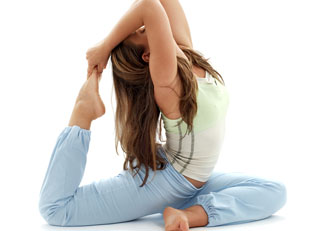History
Hatha Yoga was first established in the 15th century in India by Yogi Swatmarama. It is best described in a publication known as the Hatha Yoga Pradpika. This branch of yoga is one of 4 main branches of Tantra Yoga in the Indian tradition. The primary concentration is on asanas, or postures, and breath control, or pranayama. These techniques are used to bring energy to nadis, or system of subtle channels. Nadis include cords, vessels, nerves, veins, lymphs and arteries. So, traditional Hatha Yoga focuses on the 3rd and 4th limbs of the 8 limbs of yoga.
Hatha Yoga became popular in the Western world in the later parts of the 20th century. Hatha Yoga is also the foundation of many other variations of yoga that have developed in recent years. For example, Hatha yoga is the foundation of Bikram Yoga, Anusara Yoga and Vinyasa Yoga. In fact, when Westerners refer to the word "yoga," they are often referring to the principles of Hatha Yoga. Today, Hatha Yoga is used to create a healthy mind-body connection.
Basic Principles
Hatha Yoga is based on the principle of opposing energies. In fact, the word hatha is derived from the Sanskrit words "ha" meaning sun and "tha" meaning moon. This duality of opposites uses postures and breathing to bring the body through a purification process. Traditional hatha yoga involves postures (asana), purification (shatkriya), gestures (mudra), breathing (pranayama) and meditation. This would allow the yogi to hold positions for an extended period of time, preparing the mind for meditation.
In the West, Hatha Yoga is typically practiced as asanas and pranayamas. The goal is to improve the mind-body connection through opposing energies of poses and breath. Practicing asanas teaches balance, strength and poise. Pranayamas improve oxygenation in the body. The combination of these skills can relieve stress and relax the body.
Poses
The asanas in Hatha Yoga are designed for 2 reasons. First, in order to achieve meditation, you must be perfectly still for a significant period of time. Practicing asanas can lead to better meditation. Focusing on the improvement of postures leads to an improvement of the inner skills of meditation. Second, by practicing poses, or asanas, more energy is brought to the body and mind. This energy opens the nadis, or inner channels. Mastering individual poses in traditional Hatha Yoga is not the objective. Rather, it is a process of improving concentration and will power, while not paying attention to outside sensory information.
As a form of exercise, the poses in Hatha Yoga help improve flexibility, posture and range of movement. They also regulate and deepen respiration. Poses should be performed slowly and carefully. It is important to never force or strain in a pose. Practicing these poses can help strength the body and improve balance. Furthermore, many people describe Hatha Yoga as having a calming and relaxing effect while also feeling energized.
Some examples of typical Hatha Yoga poses include bridge pose, spinal twist and cat stretch. The bridge pose firms and strengthens the back, thighs and buttocks. It also opens the chest, which increases lung capacity and improves circulation. The spinal twist helps to prevent pinched nerves and keeps the spine aligned. To loosen the back and pelvis, the cat stretch is performed. This stretch also works to relax and stretch the shoulders. All poses are paired with appropriate breathing techniques.
Who This is For
Traditional Hatha Yoga has a very relaxed feeling. Many people find it slow and meditative. This is a great choice for beginners who are looking to learn traditional poses and become more comfortable with yoga. Many beginning classes included slow-paced poses and relaxation techniques.



